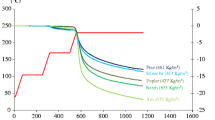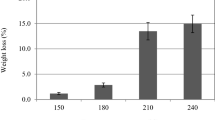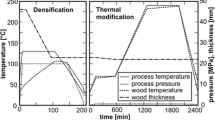Abstract
The mechanism by which modified wood resists decay has long been discussed, but is still not fully understood. A better understanding of decay resistance mechanisms could improve wood protection processes and product properties. In this study, the dynamics of brown rot decay in thermally modified wood was examined through measurements of mass loss, strength loss and gene expression. Close monitoring of mass loss over 120 days in thermally modified wood exposed to Postia placenta showed a delay in the onset of degradation compared to untreated wood, and once the degradation had started, the rate was lower. Thermally modified wood did not inhibit expression of wood degradation-related genes before mass loss and was similar to that in untreated wood once mass loss could be detected. Comparing gene expression as well as strength loss at the same stage of decay rather than at the same time after exposure showed smaller differences in decay patterns between thermally modified and untreated wood than previous results indicate. It is concluded that the key to understanding degradation resistance in thermally modified wood is to compare the decay patterns in thermally modified wood and untreated wood before mass loss occurs.




Similar content being viewed by others
References
Alfredsen G, Fossdal CG (2009) Postia placenta gene expression of oxidative and carbohydrate metabolism related genes during growth in furfurylated wood. Document No. IRG/WP 09-10701. The International Research Group on Wood Protection. Stockholm, Sweden
Alfredsen G, Fossdal CG (2010) Postia placenta gene expression during growth in furfurylated wood. Document No. IRG/WP 10–10734. The International Research Group on Wood Protection. Stockholm, Sweden
Alfredsen G, Pilgård A (2014) Postia placenta decay of acetic anhydride modified wood—effect of leaching. Wood Mater Sci Eng 9(3):162–169
Bravery AF (1979) A miniaturised wood-block test for the rapid evaluation of wood preservative fungicides. In: Screening techniques for potential wood preservative chemicals. Proceedings of a special seminar held in association with the 10th annual meeting of the IRG, Peebles 1978. Swedish Wood Preservation Institute Report No. 136. Stockholm
Brischke C, Welzbacher CR, Huckfeldt T (2008) Influence of fungal decay by different basidiomycetes on the structural integrity of Norway spruce wood. Holz Roh Werkst 66:433–438
Cohen R, Jensen KA, Houtman CJ, Hammel KE (2002) Significant levels of extracellular reactive oxygen species produced by brown rot basidiomycetes on cellulose. FEBS Lett 531:483–488
Cohen R, Suzuki MR, Hammel KE (2004) Differential stress-induced regulation of two quinone reductases in the brown rot basidiomycete Gloeophyllum trabeum. Appl Environ Microbiol 70:324–331
Eastwood DC et al (2011) The plant cell wall-decomposing machinery underlies the functional diversity of forest fungi. Science 333(6043):762–765
EN 84 (1996) Wood preservatives—accelerated ageing of treated wood prior to biological testing. Leaching procedure. European Committee for Standardization (CEN), Brussels
Eriksson KEL, Blanchette RA, Ander P (1990) Microbial and enzymatic degradation of wood and wood components. Springer, Berlin
Espejo E, Agosin E (1991) Production and degradation of oxalic acid by brown rot fungi. Appl Environ Microbiol 57:1980–1986
Esteves BM, Pereira HM (2009) Wood modification by heat treatment: a review. BioResources 4:370–404
Goodell B (2003) Brown-rot fungal degradation of wood: our evolving view. In: Goodell B, Nicholas DD, Schultz TP (eds) Wood deterioration and preservation. ACS symposium series, vol 845. American Chemical Society, Washington, pp 9–118
Goodell B, Jellison J, Liu G, Daniel A, Paszcynski F, Fekete S, Krishnamurthy L, Jun L, Xu G (1997) Low molecular weight chelators and phenolic compounds isolated from wood decay fungi and their role in the fungal biodegradation of wood. J Biotechnol 53:133–162
Green F, Clausen CA (2005) Copper tolerance of brown-rot fungi: oxalic acid production in southern pine treated with arsenic-free preservatives. Int Biodeterior Biodegrad 56:75–79
Hakkou M, Petrissans M, Gerardin P, Zoulalian A (2006) Investigations of the reasons for fungal durability of heat-treated beech wood. Polym Degrad Stab 91:393–397
Hastrup ACS, Green F, Lebow PK, Jensen B (2012) Enzymatic oxalic acid regulation correlated with wood degradation in four brown-rot fungi. Int Biodeterior Biodegrad 75:109–114
Hill C (2006) Wood modification: chemical, thermal and other processes. Wiley, Chichester
Hyde SM, Wood PM (1997) A mechanism for production of hydroxyl radicals by the brown-rot fungus Coniophora puteana: Fe(lll) reduction by cellobiose dehydrogenase and Fe(ll) oxidation at a distance from the hyphae. Microbiology 143:259–266
Ilmén M, Saloheimo ANU, Onnela M, Penttilä M (1997) Regulation of cellulase gene expression in the filamentous fungus Trichoderma reesei. Appl Environ Microbiol 63:1298–1306
ISO 5223 (1996) Test sieves for cereals. International Organization for Standardization, Geneve
Jensen KA, Houtman CJ, Ryan ZC, Hammel KE (2001) Pathways for extracellular Fenton chemistry in the brown rot basidiomycete Gloeophyllum trabeum. Appl Environ Microbiol 67:2705–2711
Jensen KA, Ryan ZC, Vanden Wymelenberg A, Cullen D, Hammel KE (2002) An NADH: quinone oxidoreductase active during biodegradation by the brown-rot basidiomycete Gloeophyllum trabeum. Appl Environ Microbiol 68:2699–2703
Junga U, Militz H (2005) Particularities in agar block tests of some modified woods caused by different protection and decay principles. In: Militz H, Hill C (eds) Proceedings of the 2nd European conference on wood modification, Göttingen, Germany, Oct 6–7, pp 354–362
Kerem Z, Jensen KA, Hammel KE (1999) Biodegradative mechanism of the brown rot basidiomycete Gloeophyllum trabeum: evidence for an extracellular hydroquinone-driven Fenton reaction. FEBS Lett 446:49–54
Lekounougou S, Kocaefe D (2013) Bioresistance of thermally modified Populus tremuloides (North American Aspen) wood against four decay fungi. Int Wood Prod J 4:46–51
Lekounougou S, Kocaefe D (2014a) Durability of thermally modified Pinus banksiana (Jack pine) wood against brown and white rot fungi. Int Wood Prod J 5:92–97
Lekounougou S, Kocaefe D (2014b) Impact of thermal modification on bioresistance of North American wood species, Pinus banksiana, Populus tremuloides, and Betula papyrifera, against wood-rotting basidiomycete fungi. Wood Mater Sci Eng 9:67–75
Margolles-Clark E, Ihnen M, Penttilä M (1997) Expression patterns of ten hemicellulase genes of the filamentous fungus Trichoderma reesei on various carbon sources. J Biotechnol 57:167–179
Martinez D et al (2009) Genome, transcriptome, and secretome analysis of wood decay fungus Postia placenta supports unique mechanisms of lignocellulose conversion. Proc Natl Acad Sci USA 106:1954–1959
Militz H (2002) Thermal treatment of wood: European processes and their background. In, Document No. IRG/WP 02–40241. The International Research Group on Wood Protection. Stockholm, Sweden
Mohareb A, Sirmah P, Pétrissans M, Gérardin P (2011) Effect of heat treatment intensity on wood chemical composition and decay durability of Pinus patula. Eur J Wood Prod 70:519–524
Paszczynski A, Crawford R, Funk D, Goodell B (1999) De novo synthesis of 4,5-dimethoxycatechol and 2,5-dimethoxyhydroquinone by the brown rot fungus Gloeophyllum trabeum. Appl Environ Microbiol 65:674–679
Pilgård A, Alfredsen G, Fossdal CG, Long II CJ (2012) The effects of acetylation on the growth of Postia placenta over 36 weeks. Document No. IRG/WP 12–40589. The International Research Group on Wood Protection. Stockholm, Sweden
Qi W, Jellison J (2004) Induction and catalytic properties of an intracellular NADH dependent 1,4-benzoquinone reductase from the brown-rot basidiomycete Gloeophyllum trabeum. Int Biodeterior Biodegrad 54:53–60
Rapp AO, Brischke C, Welzbacher CR (2006) Interrelationship between the severity of heat treatments and sieve fractions after impact ball milling: a mechanical test for quality control of thermally modified wood. Holzforschung 60:64–70
Riley R et al (2014) Extensive sampling of basidiomycete genomes demonstrates inadequacy of the white-rot/brown-rot paradigm for wood decay fungi. Proc Natl Acad Sci USA 111:9923–9928
Ringman R, Pilgård A, Brischke C, Richter K (2014a) Mode of action of brown rot decay resistance in modified wood: a review. Holzforschung 68:239–246
Ringman R, Pilgård A, Richter K (2014b) Effect of wood modification on gene expression during incipient Postia placenta decay. Int Biodeterior Biodegrad 86:86–91
Schmöllerl B, Alfredsen G, Fossdal CG, Westin M, Steitz A (2011) Molecular investigation of Postia placenta growing in modified wood. Document No. IRG/WP 11-10756. The International Research Group on Wood Protection. Stockholm, Sweden
Steenkjær Hastrup AC, Jensen TØ, Jensen B (2013) Detection of iron-chelating and iron-reducing compounds in four brown rot fungi. Holzforschung 67:99–106
Tjeerdsma BF, Boonstra M, Pizzi A, Militz H (1998) Characterisation of thermally modified wood: molecular reasons for wood performance improvement. Holz Roh Werkst 56:149–153
Vanden Wymelenberg A et al (2010) Comparative transcriptome and secretome analysis of wood decay fungi Postia placenta and Phanerochaete chrysosporium. Appl Environ Microbiol 76:3599–3610
Wardman P (1989) Reduction potentials of one-electron couples involving free radicals in aqueous solution. J Phys Chem Ref Data 18:1637–1755
Wei D, Houtman CJ, Kapich AN, Hunt CG, Cullen D, Hammel KE (2010) Laccase and its role in production of extracellular reactive oxygen species during wood decay by the brown rot Basidiomycete Postia placenta. Appl Environ Microbiol 76(7):2091
Acknowledgments
The authors would like to thank Paul-Simon Schroll for his outstanding work in the laboratory. We also gratefully acknowledge financial support from the Swedish Research Council Formas 213-2011-1481.
Author information
Authors and Affiliations
Corresponding author
Rights and permissions
About this article
Cite this article
Ringman, R., Pilgård, A., Kölle, M. et al. Effects of thermal modification on Postia placenta wood degradation dynamics: measurements of mass loss, structural integrity and gene expression. Wood Sci Technol 50, 385–397 (2016). https://doi.org/10.1007/s00226-015-0791-z
Received:
Published:
Issue Date:
DOI: https://doi.org/10.1007/s00226-015-0791-z




